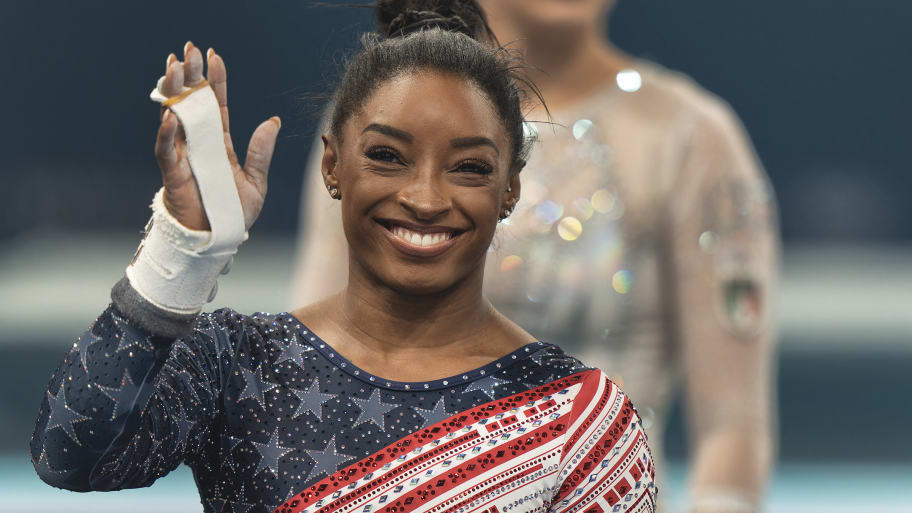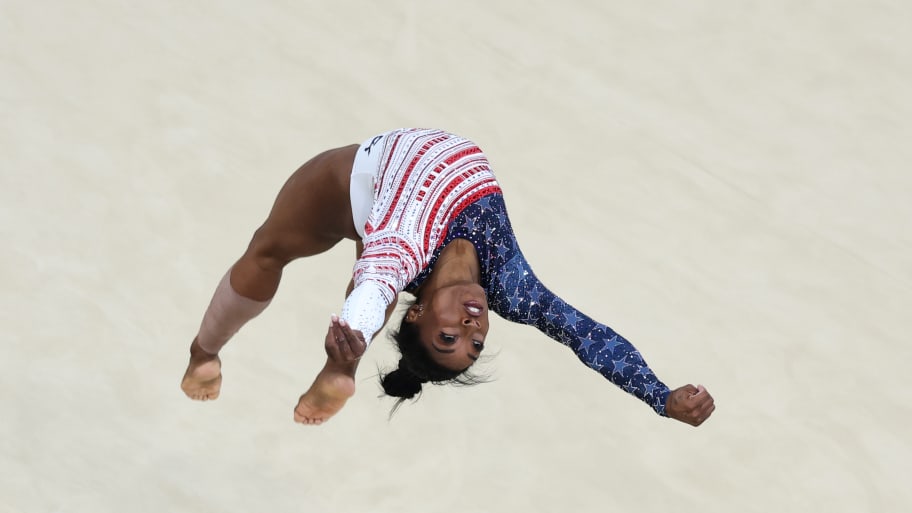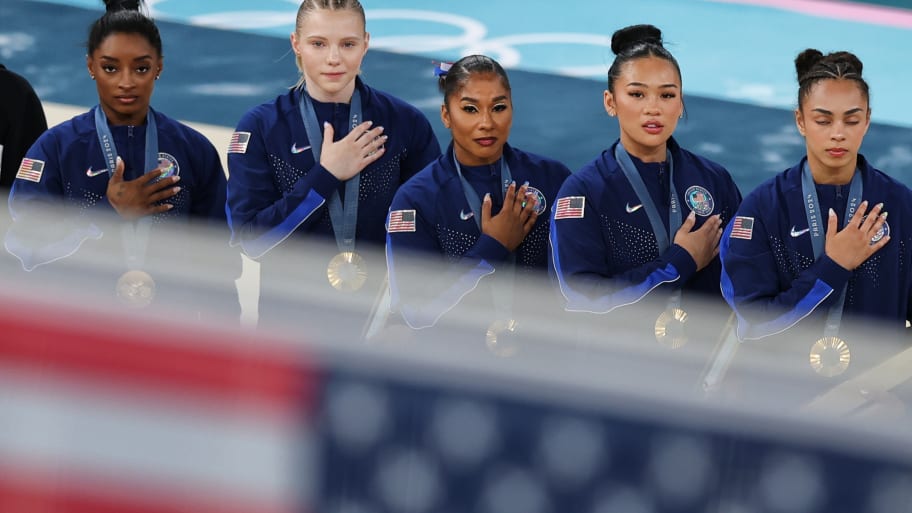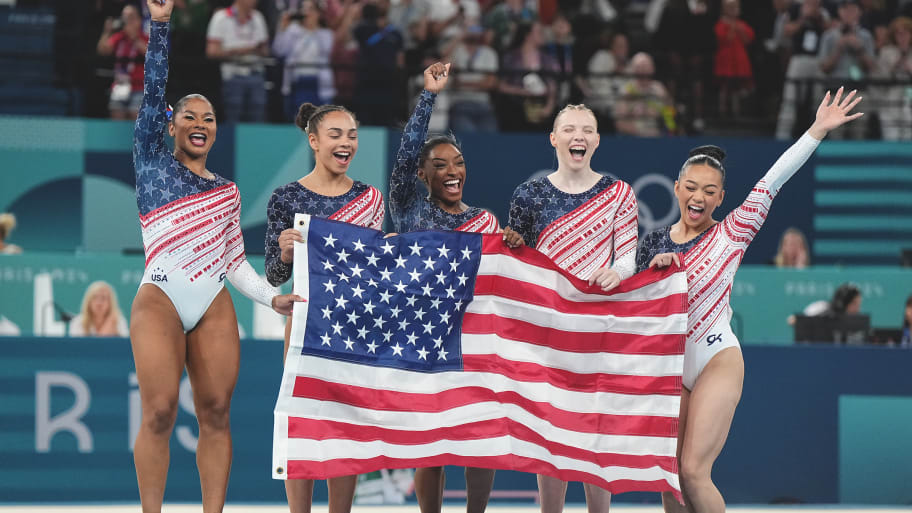
PARIS — Just like in 1996, the U.S. women’s gymnastics team won Olympic gold wearing white leotards that made them appear to be draped in the American flag. Unlike in 1996, they also wore smiles.
“We’re out here really having fun and enjoying what we’re doing,” said Simone Biles.
That, perhaps even more than the hardware—with Tuesday’s victory, that’s 16 Olympic medals for the program since Biles became a senior in 2013—is the Simone Biles effect.
American gymnasts were once afraid to deviate from approved lines during interviews. On Tuesday, they spent most of their press conference teasing one another. As Jordan Chiles pondered her answer to a question about how Biles has changed the culture of gymnastics, Biles cut in: “Everything that Jordan does, she learned from me.”
Chiles glared at her. “No, I had my own personality before I met you!”
Biles rolled her eyes. “Watch my beam warmup and then watch Jordan’s.”
Eventually they called a truce, and Chiles elaborated: “The fun,” she said. “I feel like she’s always had fun. … Simone has always had an amazing personality, but I feel like maybe now that she’s been around the younger generation, we've kind of amplified her fun-ness.”
Biles added, “But I also think gymnasts—they used to try to put us in a box, and they were like, ‘If you [aren’t] like this, then you’re not going to be successful.’ And whenever I kind of came around, it wasn’t really my style. At the [Károlyi Ranch, the former national team training facility], nobody really would talk and laugh and all that stuff. But I was like, Yeah, that’s not how I do gymnastics. So I’m going to continue to do it, how I know and how I love, because it's the reason why I fell in love with the sport. So once that started changing and Márta [Karolyi] started understanding that, the girls started showing a little bit more of their personality. So over the years, we’ve gotten to do that and now, I think it just [speaks to] the longevity as well. A lot of us are in our 20s. We have Hezly [Rivera] over there; she’s 16. But now we can show off our personalities, really have fun, but then also know that once we get on the floor, we’re going to put in work and we’re going to show the results and we don’t have to be put in the box anymore.”

As she always does, Biles, 27, fielded questions about her legacy and largely demurred. Eight Olympic medals, the most ever for an American gymnast; 38 total Olympic and world championship medals, extending her lead as the most decorated gymnast of all time; five eponymous skills, with a chance to add a sixth this week? “I would’ve had to Google that,” she said. “I don’t keep count.” In the past, Biles has said, she got caught up worrying about what others wanted her to do. This Olympic run is just for her.
But this is what she will leave behind whenever she is done: a team that looks more like her, in so many ways.

When Biles was a child, she believed her ceiling was a college scholarship; she had never seen a Black gymnast have success beyond that. Then she watched Gabby Douglas at the 2012 Olympics and changed her goal. Now four of the top U.S. gymnasts are Black: Chiles; and Shilese Jones and Skye Blakely, both members of the American 2023 world championship team who both sustained injuries that cost them a chance at U.S. Olympic Trials. Along with Suni Lee, who is Hmong American, and Rivera, whose parents were born in the Dominican Republic, the Olympic team is 80% people of color, the highest percentage in history.
When Biles was young, most female gymnasts peaked before they finished high school. Before Tokyo, the oldest all-around gold medalist in the past 50 years was 20-year-old Simona Amanar, of Romania, in 2000. But Biles likes to say she is aging “like fine wine,” and the rest of the sport has taken note. For the first time since 1952, the U.S. sent four gymnasts to a second Olympics: Biles; Jade Carey, 24; Chiles, 23; and Lee, 21. The team’s average age of 22.47 is the highest in U.S. history by more than a year.
And then there are the smiles. At the Károlyi Ranch, 60 miles north of Houston, where Béla and Márta Károlyi ruled the U.S. gymnastics program, athletes followed rules that many have said amounted to abuse. Their facility was also the site of many of the attacks perpetrated by former team doctor Larry Nassar, who pleaded guilty in November 2017 to 10 counts of first-degree criminal sexual conduct with a minor. By the time his sentencing hearing began, on Jan. 16, 2018, more than 120 women and girls had said he abused them. Nassar was sentenced to 40 to 175 years in state prison; that time will begin once he is finished serving 60 years in federal prison for child-pornography charges. (When Dominique Moceanu, who was 14 when she won gold as part of the 1996 Magnificent Seven team, told The Los Angeles Times in 2008 that Márta had once grabbed her by her injured neck and Béla had berated her about her weight, Márta said, “I feel sad that a gymnast so accomplished as Dominique, being a part of the 1996 Olympic team and being the individual medalist in the 1995 world championships, can remember the harder days during the preparation. I feel sad.” The Károlyis have otherwise denied all allegations.) Over the three decades the Károlyis reigned, many gymnasts surely tried to insert some levity into the program. But none succeeded, likely because none was Simone Biles.

Being the greatest of all time brings with it cachet, as Biles has learned in recent years. In 2021, she released a statement acknowledging that she too had been abused by Nassar and lamenting that the road to Tokyo would run through the place where she was assaulted. Three days later, USA Gymnastics severed ties with the Károlyi Ranch. That August, Biles criticized new USAG president Kerry Perry for her silence on the issue. Three weeks later, Perry, also under pressure from the USOPC after hiring a Nassar defender to a high-level position, resigned. USAG replaced Perry with Mary Bono, who just weeks before starting the job had tweeted a photo of herself coloring over a Nike logo, apparently in response to the company’s work with Colin Kaepernick. After the post surfaced, Biles (who also had a Nike deal) remarked on X, “don’t worry, it’s not like we needed a smarter usa gymnastics president or any sponsors or anything.” Four days later Bono resigned, too.
In Tokyo, Biles contracted a case of the twisties, a sort of vertigo in which gymnasts lose their sense of where they are in the air and can risk paralysis. She withdrew from event after event, eventually jettisoning the twisting elements from her balance beam routine and gutting out a bronze medal that she called the most meaningful of her career. She took a year off from gymnastics and two off from competing before returning and dominating the world the way she always had. Carey, Chiles and Lee, too, have suffered adversity, mostly health related. But they have resisted suggestions that this team dub itself the Redemption Five or anything similar. (“Redemption Team plus Hezly,” Biles joked.)
On Tuesday night, asked what this group calls itself, Biles almost declined to answer. She tried to get away with just an abbreviation, but eventually, after some encouragement from her teammates, she caved. Internally, she admitted, they have been referring to themselves as the F--- Around and Find Out Five. “That’s the inside name,” she insisted. Just like this Olympics, it’s just for them.
This article was originally published on www.si.com as The Simone Biles Effect Has Undeniably Transformed U.S. Gymnastics.







